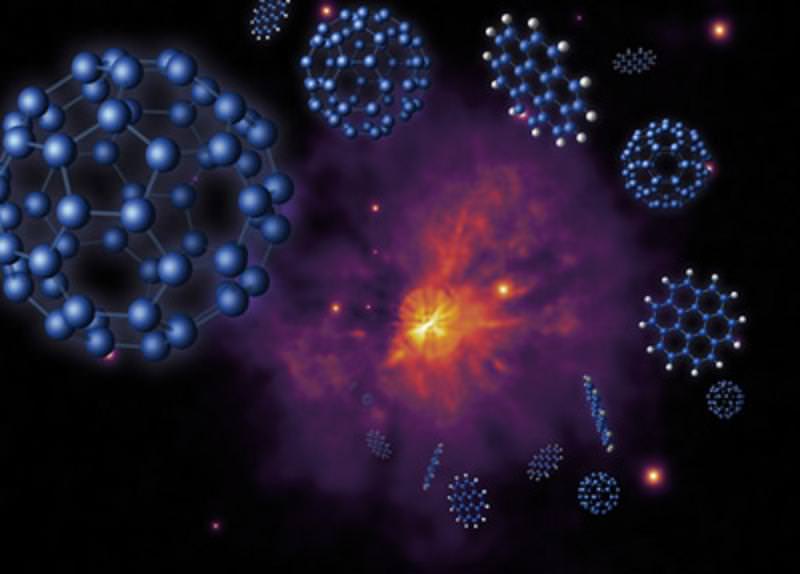[/caption]When I first heard about buckyballs a couple of decades ago, I had nothing but the deepest respect for anyone who understood abstract ideas like string theory and branes. After all, how often were you likely to discuss Buckminster fullerenes with a contemporary while standing in the laundry detergent aisle of your local grocery store? The very concept of “magnetic” carbon was new and exciting! It was known to exist in small quantities in nature – produced by lightning and fire – but the real kicker was born solely in a laboratory. Buckyballs have been found on Earth and in meteorites, and now in space, and can act as “cages” to capture other atoms and molecules. Some theories suggest that the buckyballs may have carried to the Earth substances that make life possible.
According to the McDonald Observatory press release: Observations made with NASA’s Spitzer Space Telescope have provided surprises concerning the presence of buckminsterfullerenes, or “buckyballs,” the largest known molecules in space. A study of R Coronae Borealis stars by David L. Lambert, Director of The University of Texas at Austin’s McDonald Observatory, and colleagues shows that buckyballs are more common in space than previously thought. The research will appear in the March 10 issue of The Astrophysical Journal. The team found that “buckyballs do not occur in very rare hydrogen-poor environments as previously thought, but in commonly found hydrogen-rich environments and, therefore, are more common in space than previously believed,” Lambert says.
Buckyballs are made of 60 carbon atoms arranged in shape similar to a soccer ball, with patterns of alternating hexagons and pentagons. Their structure is reminiscent of Buckminster Fuller’s geodesic domes, for which they are named. These molecules are very stable and difficult to destroy. Richard Curl, Harold Kroto, and Richard Smalley won the 1996 Nobel Prize in chemistry for synthesizing buckyballs in a laboratory. The consensus based on lab experiments has been that buckyballs do not form in space environments that have hydrogen, because the hydrogen would inhibit their formation. Instead, the idea has been that stars with very little hydrogen but rich in carbon — such as the so-called “R Coronae Borealis stars” — provide an ideal environment for their formation in space.
Lambert, along with N. Kameswara Rao of Indian Institute of Astrophysics and Domingo Anibal García-Hernández of the Instituto de Astrofisica de Canarias, put these theories to the test. They used Spitzer Space Telescope to take infrared spectra of R Coronae Borealis stars to look for buckyballs in their chemical make-up. They found these molecules do not occur in those R Coronae Borealis stars with little or no hydrogen, an observation contrary to expectation. The group also found that buckyballs do exist in the two R Coronae Borealis stars in their sample that contain a fair amount of hydrogen. Studies published last year, including one by García-Hernández, showed that buckyballs were present in planetary nebulae rich in hydrogen. Together, these results tell us that fullerenes are much more abundant than previously believed, because they are formed in normal and common “hydrogen-rich” and not rare “hydrogen-poor” environments.
The current observations have changed our understanding of how buckyballs form. It suggests they are created when ultraviolet radiation strikes dust grains (specifically, “hydrogenated amorphous carbon grains”) or by collisions of gas. The dust grains are vaporized, producing an interesting chemistry where buckyballs and polycyclic aromatic hydrocarbons are formed. (The latter molecules of a variety of sizes are formed from carbon and hydrogen.) “In recent decades, a number of molecules and diverse dust features have been identified by astronomical observations in various environments. Most of the dust that determines the physical and chemical characteristics of the interstellar medium is formed in the outflows of asymptotic giant branch stars and is further processed when these objects become planetary nebulae.” says Jan Cami (et al). “We studied the environment of Tc 1, a peculiar planetary nebula whose infrared spectrum shows emission from cold and neutral C60 and C70. The two molecules amount to a few percent of the available cosmic carbon in this region. This finding indicates that if the conditions are right, fullerenes can and do form efficiently in space.”


Cool – They’re just such a whackily awesome molecule…
The next step is to somehow connect Buckyballs to the formation of DNA, RNA, or some pre-curser molecule as such, and we have possible the cosmic connection to life everywhere.
I haven’t kept up with this side of carbon chemistry. In thin film deposition hydrogen helps making unusual carbon conformations such as diamond films, so I had likely naively suspected what is now found.
IIRC one specific pathway fullerenes admit is believed to be supplying Titan’s surface with energetic oxygen ions trapped within, from cosmic radiation et cetera up in the outer atmosphere layers that form complex hydrocarbons such as fullerenes. (I’m pretty sure I can dig up the reference if need be.) This is one way that Titan could admit interesting pro-, proto- or life chemistry.